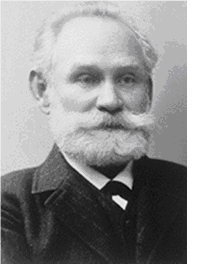Ivan Pavlov (1849–1936) was a Russian psychologist interested in animal and human learning who developed the concept of conditioning to describe the psychological processes of learning. He won the Nobel Prize for Medicine in 1904. Pavlov draws the distinction between an unconditioned (instinctive) and conditioned (environmental and learnt) reflex in response to a stimulus. Here, E.L. Thorndike describes Pavlov’s experiment.

By virtue of an inborn or unconditional or unconditioned reflex or tendency, the dog increases the flow of its saliva when certain substances, such as foods or rejectable objects like acid, find their way into its mouth. Suppose now that a certain situation, say, the sound of an electric buzzer, is presented to the animal and while this sound continues, food is presented, and that his connection is repeated daily of oftener a number of times. Then if the sound of the buzzer is presented alone, there will be an increased flow of the saliva (Thorndike, E.L. 1931 (1968). Human Learning. New York: Johnson Reprint Corporation. pp. 104-105.).
 |
| One of Pavlov’s dogs, preserved in the Pavlov Museum, St Petersburg |
These were Pavlov’s conclusions:
Both the facts [responding to the food or acid and responding to the buzzer that has come to be associated with the food or buzzer] are equally accurate and constant; and to both the same physiological term ‘reflex’ should be applied … But at the same time the difference between the two reflexes is likewise apparent … [A]s may be clearly seen from the above experiments, the first reflex was produced without any preparation, without any condition, while the second was obtained by virtue of a special procedure … [W]e may rightly name a permanent connection between an external agent and the activity of the organism called forth in response to it ‘an unconditioned reflex’, while a temporary connection may be defined as ‘a conditioned reflex’. …
The animal organism as a system exists in surrounding nature only by means of a constant balancing of this system and its environment, i.e., by means of definite reactions of the living system to the excitations reaching it from outside, which in the case of the higher animals is effected mainly by means of the nervous system in the form of reflexes. The primary means of securing this equilibrium, and consequently the integrity of both an individual organism and its species, are the most simple unconditioned reflexes generally … as well as the most complex unconditioned reflexes generally known as instincts—the alimentary instinct, the defense instinct, the sexual instinct, etc. These reflexes are evoked both by internal agents, originating in the organism itself, and by external agents, owing to which fact the perfection of the equilibrium may be secured. However, the equilibrium achieved by means of these reflexes would have been perfect only providing the environment had been absolutely permanent. But as the environment, in addition to being extremely varied, is constantly fluctuating, the unconditioned connections, being of a permanent nature, prove to be insufficient and have to be supplemented by conditioned reflexes, i.e., temporary connections … The same may be said of anything that might be necessary to secure the well-being of an organism or a species both in a positive and a negative sense, i.e., to anything that has to be removed from the environment or to be guarded against.
It needs no great imagination to see at once what countless numbers of conditioned reflexes are constantly used by the most complex system of man, a system placed in an often widely varied general natural environment and, besides, in a special social environment which in its extreme limit may mean the whole of mankind. Let us consider the same food reflex. What a number of different conditioned temporary connections, both natural and especially social, are necessary to ensure a sufficient supply of food—and all these are essentially conditioned reflexes.
Pavlov, I.P. 1941. ‘The Conditioned Reflex.’ Pp. 166–185 in Lectures on Conditioned Reflexes: Vol. 2. Conditioned Reflexes and Psychiatry, edited by W. Horsley Gantt. New York: International Publishers. pp. 168–170. || WorldCat
